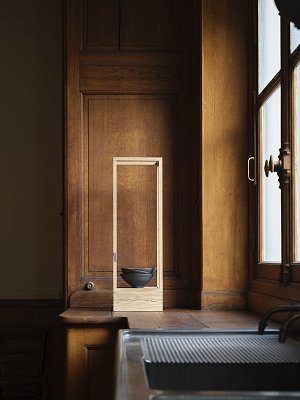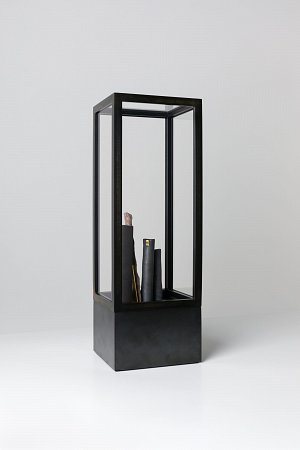This is a street I know well. This beautiful
hill of golden houses on the edge of the
Parc Monceau is a street of beginnings,
a place for families to settle and start
to become French. The stories are
lambent and they are fissile and they
break your heart.

Moïse de Camondo and his son, Lieutenant Nissim de Camondo, in the garden at 63, rue de Monceau, summer 1916
Archives of the Musée Nissim de Camondo
© MAD, Paris
The musée Nissim de Camondo has been
in my life for a long time. My grandmother
visited her cousins here in the 1920s, they
lived ten houses up from the museum.
I haunted it when researching the history
of a collection I had inherited, bought
in the 1870s. So to receive an invitation
to make an exhibition here in this
family house was an honour mixed with
anxiety. It is not simple. It should never
be straightforward to bring anything
new into a place that is so storied.
Here is a tremor of trespass. Where is offlimits?
This house is not an empty house.
It is far from empty. In his will Moïse
de Camondo writes that he doesn’t want
anyone to move anything. Don’t lend
things. Keep the blinds down, keep the
dust away, don’t add objects to these
collections.
These rooms are a work of art
in themselves, a place of memory for
his father and for his son, killed in the
war. This gift to France was Moïse’s
way of reaching into the future through
memorial. It did not protect his family. It has
become a memorial to Moïse’s daughter,
Béatrice, her husband Léon and their two
children, Fanny and Bertrand, murdered
in Auschwitz.

Edmund de Waal, muet, V, installation view, Musée Nissim de Camondo, 2021
© MAD, Paris / Christophe Dellière. Courtesy of the artist and of Musée des Arts Décoratifs, Paris
I listen to him. I listen to the house.
It is a house of sounds from the kitchens,
the butler’s pantry, the library. And then
I go to my studio and start to make things
out of porcelain and gold and stone.
I think of where I can place them so that
they gently amplify some of the echoes
of the house, hold some of the silences.
I think that it is possible to be here,
briefly. I think it is possible not to move
things, but to add. For this is a house
of archives, of things cared for and put
away. In the attics you open one door
of a cupboard and it is full of light fittings,
another and it has Louis Vuitton luggage.
One room is full of gilded chairs. Béatrice’s
dressing room has furniture shrouded with
dust sheets.
In my studio I write to Moïse about
collecting, about being Jewish, about
food and dogs and Proust and family and
belonging. And mourning. The letters
multiply until there are fifty-eight Lettres
à Camondo, a book.
And I make small groups out of porcelain
and oak and gold. I shuffle these porcelain
fragments. I stack them onto the desks
where Moïse wrote to friends and dealers,
the desks of the chef and the butler where
they wrote their lists, their orders to the
tradespeople. I want to add another layer
to the archive. I decide that Moïse needs
another desk. He had plenty of desks.
In most rooms there is a place to sit and
write. My desk is in the form of a letter,
words written into porcelain brushed over
gold leaf. I write: I find this difficult.

Edmund de Waal, « i.m. (Nissim) », 2021
Porcelain, gold, lead,
red pigment, aluminium,
plexiglass and marble
© Edmund de Waal. Courtesy of the artist. Photo: Alzbeta Jaresova
I put some shards into a drawer of the
Sèvres table. I put some piles of porcelain
notes into the Library and a few bowls
into the Porcelain Room to keep Buffon’s
beautiful birds company. There are
some bowls stacked in the butler’s
pantry because this is where the careful
calibration of the passage of objects
is focussed.
I make five black vitrines and put lead
and shards in them. These are fragments
shored against the ruins. These are
stele for the family, for Nissim, Béatrice,
Léon, Fanny and Bertrand. They are i.m.,
in memoriam.
I put eight stone benches in the courtyard,
places to sit and pause by yourself or with
others. They are made from Hornton stone,
golden-brown with beautiful dark bands
running through them. They are polished
smooth so that they feel worn away.
A few edges have small gilded lead folds.
You may not even notice them. They are
my form of kintsugi, the manner in which
some broken porcelain in China and Japan
are repaired with lacquer and gold, a way
of marking loss.
You cannot mend this house or this family.
You can mark some of the broken places.
You can mark them properly and with
dignity, with love. And then move away
again, let the house be.
Edmund de Waal